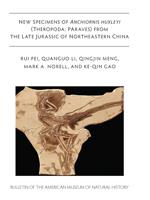Rui Pei, Quanguo Li, Qingjin Meng, Mark A. Norell, Ke-Qin Gao
Bulletin of the American Museum of Natural History 2017 (411), 1-67, (1 April 2017) https://doi.org/10.1206/0003-0090-411.1.1

Four new specimens of Anchiornis huxleyi (PKUP V1068, BMNHC PH804, BMNHC PH822, and BMNHC PH823) were recently recovered from the Late Jurassic fossil beds of the Tiaojishan Formation in northeastern China. These new specimens are almost completely preserved with cranial and postcranial skeletons. Morphological features of Anchiornis huxleyi have implications for paravian character evolution and provide insights into the relationships of major paravian lineages. Anchiornis huxleyi shares derived features with avialans, such as a straight nasal process of the premaxilla and the absence of an external mandibular fenestra in lateral view. However, Anchiornis huxleyi lacks several derived deinonychosaurian features, including a laterally exposed splenial and a specialized raptorial pedal digit II. Morphological comparisons strongly suggest Anchiornis is more closely related to avialans than to deinonychosaurians or troodontids. Anchiornis huxleyi exhibits many conservative paravian features, and closely resembles Archaeopteryx and other Jurassic paravians from Jianchang County, such as Xiaotingia and Eosinopteryx. The other Jianchang paravian, Aurornis xui, is likely a junior synonym of Anchiornis huxleyi.

